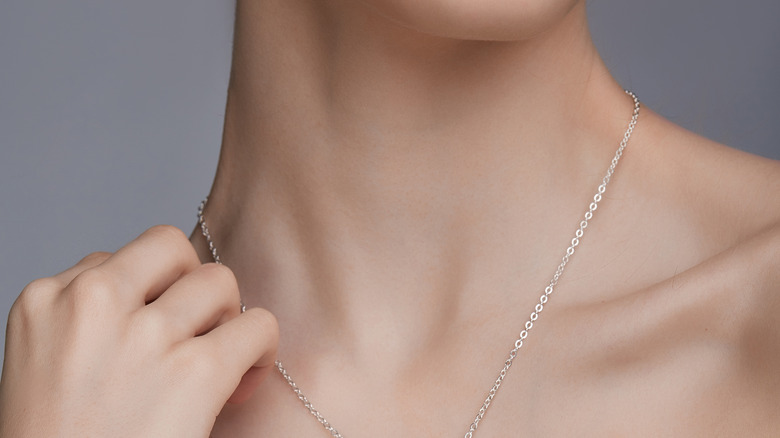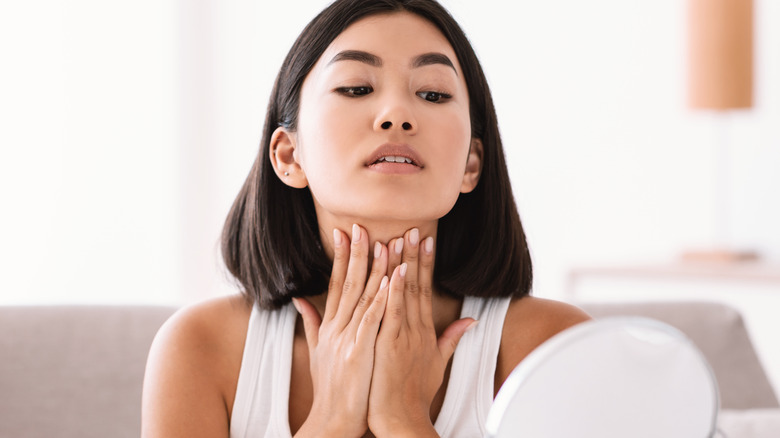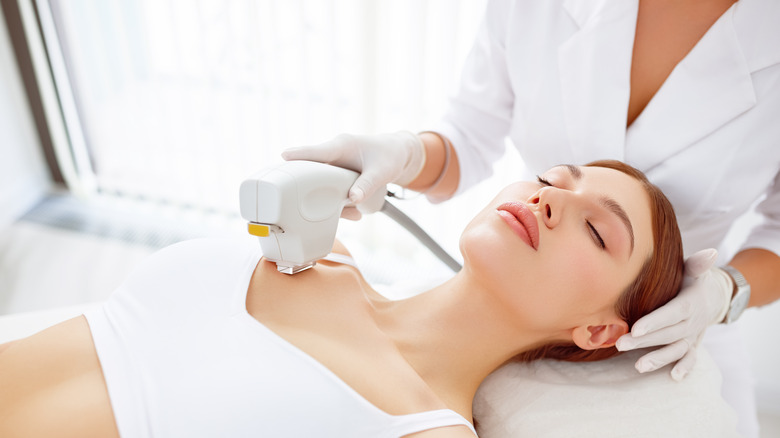The Secret Tip To Having A Less Crepey Neck And Chest
Whether your skin issue is sunspots, wrinkles, or sagging, there is a product to take care of it. Most of us take care of the skin on our face with creams, serums, and treatments to keep it looking as youthful as possible for longer. While we give our face all the TLC it needs and more, most of us tend to forget the areas right under the face: the neck and the chest. Like the skin on our face, the skin on our neck and chest are also prone to aging, and one of the signs is crepey skin.
According to Healthline, skin characterized in this way "is thin and looks finely wrinkled like crepe paper," hence the name. Crepey skin might sag and not feel tight. As we age, our body produces less collagen responsible for giving our skin its structure, so less collagen means less smooth skin. However, the most common cause of crepey skin is sun damage.
On this, New York City-based dermatologist Rachel Nazarian told Byrdie, "Volume loss and repeated folding of the skin are the two biggest causes." Aging is inevitable, but repeated habits over time can cause deeper lines in those areas sooner than they usually appear. The skin on your neck and chest is thinner, gets plenty of movement, and is exposed to the sun without the same level of care and protection. However, you can take care of the skin on your décolletage with one or two helpful tips.
Moisturize and protect your neck and chest like your face
While your face receives love from skincare products, you shouldn't stop there. MindBodyGreen recommends providing the same level of care for your neck and chest as your face by focusing on the "dermal density and epidermal framework" to focus on thinning. The outlet's go-to is its postbiotic hand cream because it has CoQ10 to strengthen your skin barrier, and your skin will appear "instantly hydrated and visibly restored." It's vital to apply sunscreen on your neck and chest, irrespective of the weather, because crepey skin is mainly caused by sun damage, per Real Simple. Choose a sunscreen of at least SPF 30 that provides broad-spectrum protection and avoid tanning as it can worsen crepey skin.
You can try glycerin or hyaluronic acid-based products on crepey skin, as recommended by Heidi A. Waldorf, the director of laser and cosmetic dermatology at Mount Sinai Hospital (via Healthline). These ingredients help attract and hold on to moisture in the area to keep them hydrated to appear fuller. On this, Marisa K. Garsnick, a board-certified dermatologist and assistant professor at Cornell University, told Byrdie, "For some ingredients, because the skin on the chest and neck can be more delicate or sensitive, it is important to remember a little goes a long way, and it may be necessary to reduce the frequency." Just remember that the skin on your décolletage is thinner than your face skin but still needs care.
Try changing your lifestyle habits
Do you know the correct way to apply skincare products? According to Skin Care Geeks, you must always apply skincare products, including sunscreen, with an upward motion. Start at the bottom and use upward strokes to allow the product to get absorbed into your skin. Gravity is real and can play a role in pulling your skin down, making it sag with a crepey appearance.
Nowadays, it seems impossible to go a day without looking at your phone, and how you look at your phone might be giving you extra lines around your neck, which is called tech neck, per Skin Care Geeks. Most people tend to look downwards when they look at their phones or laptops, and it is essential to look at gadgets at eye level instead of looking downwards to prevent crepey skin on your neck. The bad habit of looking down at screens can make you slouch and can cause creases on your chest, too, and they are called langar's lines.
It's highly recommended that you sleep on your back with a supportive pillow to prevent rolling and turning to reduce the appearance of crepey skin (via Redbook). Regarding people who sleep on their stomachs, dermatologist Patricia Wexler, M.D., an associate clinical professor of dermatology at Mount Sinai Medical Center in New York City, said, "This can accentuate horizontal bands on your neck, because your chin is tucked down." Unfortunately, this means no sleeping on your tummy anymore.
Consider dermatological in-office treatments
In addition to skincare products and lifestyle choices, dermatological in-office treatments can help treat and reduce the appearance of crepey skin on your neck and chest. One of them is fractional laser treatment (Fraxel), where they use "lasers to heat up small areas under your skin" to increase collagen production. This treatment helps to "smooth out" wrinkles from within, per Healthline. Skin Care Greeks recommends trying chemical peels as this procedure can increase collagen and elastin production to reduce the presence of crepey skin. In addition, they also help brighten the skin in those areas.
Often, skin care products and lifestyle changes might be too late to reverse the appearance of crepey skin, and in those cases, a trip to the dermatologist might give you better results. In fact, Rachel Nazarian told Byrdie, "I love procedures that trigger the production of collagen and elastin while minimizing surface sun damage—like micro-needling and a Fraxel laser." For a little extra help in the area, Redbook recommends trying ultherapy that can "tighten the skin." You will need one to three sessions for this treatment depending on the amount of crepey skin you have, and you can see results between four to six weeks. It will cost you anywhere between $1,500 to $6,000.
Ultimately, to get healthy-looking and smooth skin on your neck and chest, make sure to give it the same love and attention you give your face.



